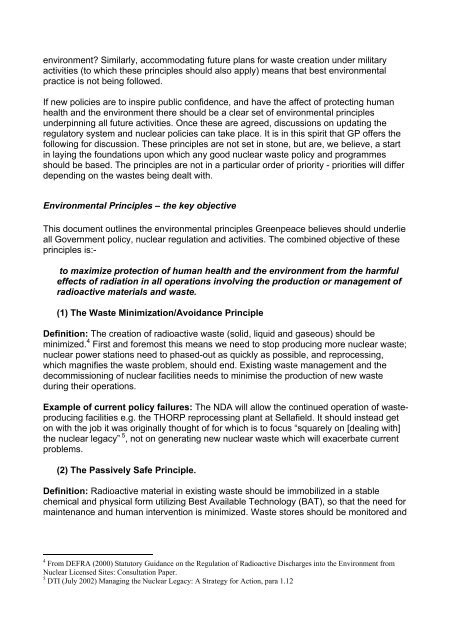environmental principles for radioactive waste ... - Greenpeace UK
environmental principles for radioactive waste ... - Greenpeace UK
environmental principles for radioactive waste ... - Greenpeace UK
You also want an ePaper? Increase the reach of your titles
YUMPU automatically turns print PDFs into web optimized ePapers that Google loves.
environment? Similarly, accommodating future plans <strong>for</strong> <strong>waste</strong> creation under military<br />
activities (to which these <strong>principles</strong> should also apply) means that best <strong>environmental</strong><br />
practice is not being followed.<br />
If new policies are to inspire public confidence, and have the affect of protecting human<br />
health and the environment there should be a clear set of <strong>environmental</strong> <strong>principles</strong><br />
underpinning all future activities. Once these are agreed, discussions on updating the<br />
regulatory system and nuclear policies can take place. It is in this spirit that GP offers the<br />
following <strong>for</strong> discussion. These <strong>principles</strong> are not set in stone, but are, we believe, a start<br />
in laying the foundations upon which any good nuclear <strong>waste</strong> policy and programmes<br />
should be based. The <strong>principles</strong> are not in a particular order of priority - priorities will differ<br />
depending on the <strong>waste</strong>s being dealt with.<br />
Environmental Principles – the key objective<br />
This document outlines the <strong>environmental</strong> <strong>principles</strong> <strong>Greenpeace</strong> believes should underlie<br />
all Government policy, nuclear regulation and activities. The combined objective of these<br />
<strong>principles</strong> is:-<br />
to maximize protection of human health and the environment from the harmful<br />
effects of radiation in all operations involving the production or management of<br />
<strong>radioactive</strong> materials and <strong>waste</strong>.<br />
(1) The Waste Minimization/Avoidance Principle<br />
Definition: The creation of <strong>radioactive</strong> <strong>waste</strong> (solid, liquid and gaseous) should be<br />
minimized. 4 First and <strong>for</strong>emost this means we need to stop producing more nuclear <strong>waste</strong>;<br />
nuclear power stations need to phased-out as quickly as possible, and reprocessing,<br />
which magnifies the <strong>waste</strong> problem, should end. Existing <strong>waste</strong> management and the<br />
decommissioning of nuclear facilities needs to minimise the production of new <strong>waste</strong><br />
during their operations.<br />
Example of current policy failures: The NDA will allow the continued operation of <strong>waste</strong>producing<br />
facilities e.g. the THORP reprocessing plant at Sellafield. It should instead get<br />
on with the job it was originally thought of <strong>for</strong> which is to focus “squarely on [dealing with]<br />
the nuclear legacy” 5 , not on generating new nuclear <strong>waste</strong> which will exacerbate current<br />
problems.<br />
(2) The Passively Safe Principle.<br />
Definition: Radioactive material in existing <strong>waste</strong> should be immobilized in a stable<br />
chemical and physical <strong>for</strong>m utilizing Best Available Technology (BAT), so that the need <strong>for</strong><br />
maintenance and human intervention is minimized. Waste stores should be monitored and<br />
4 From DEFRA (2000) Statutory Guidance on the Regulation of Radioactive Discharges into the Environment from<br />
Nuclear Licensed Sites: Consultation Paper.<br />
5 DTI (July 2002) Managing the Nuclear Legacy: A Strategy <strong>for</strong> Action, para 1.12




![[2007] EWHC 311 - Greenpeace UK](https://img.yumpu.com/22079793/1/184x260/2007-ewhc-311-greenpeace-uk.jpg?quality=85)











